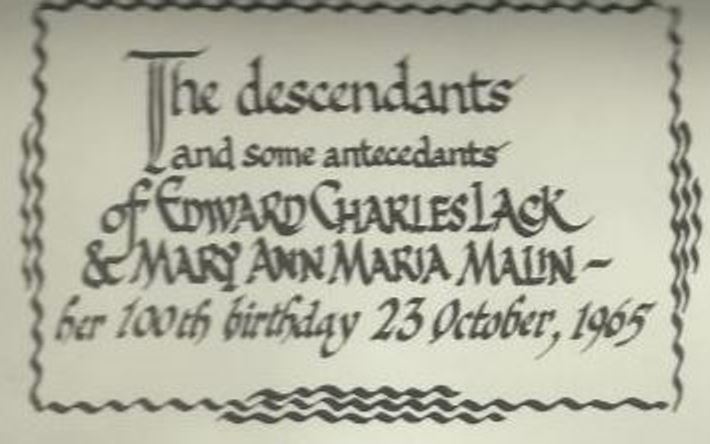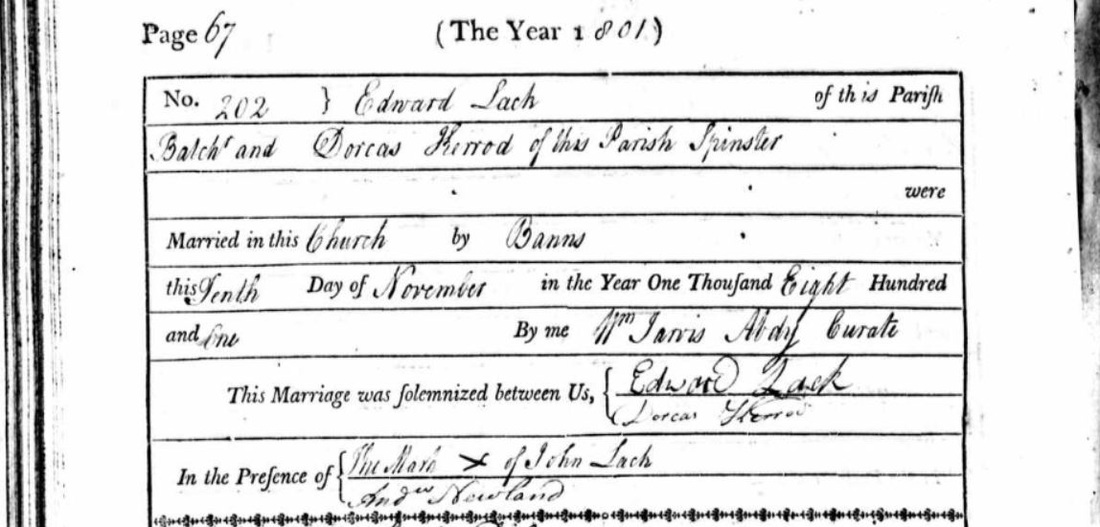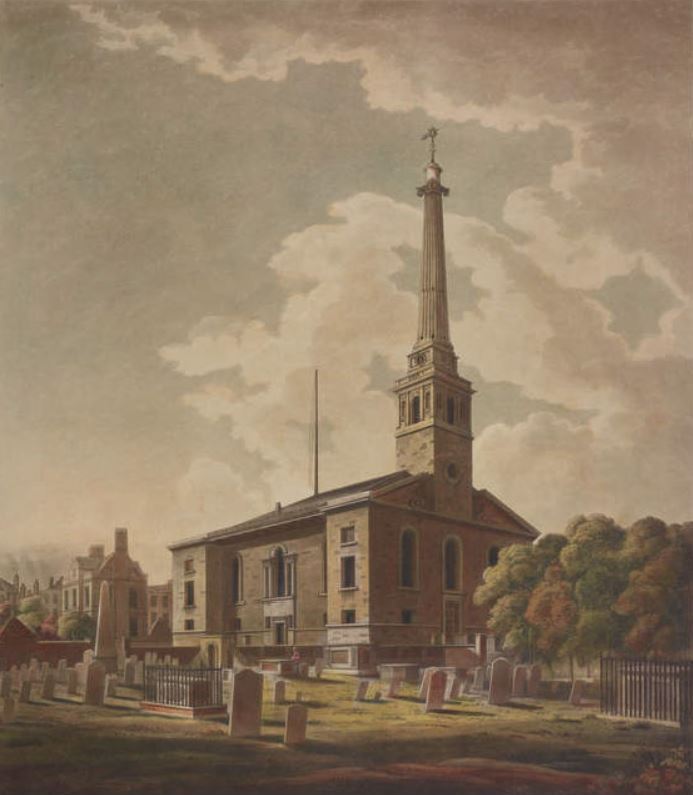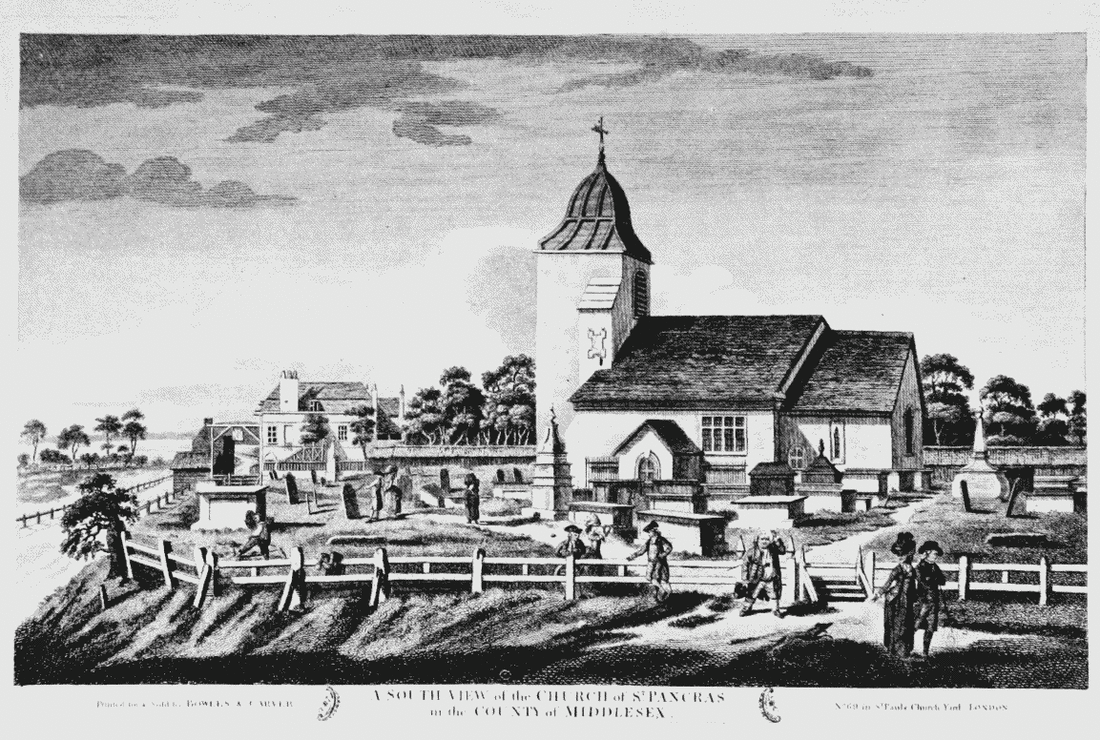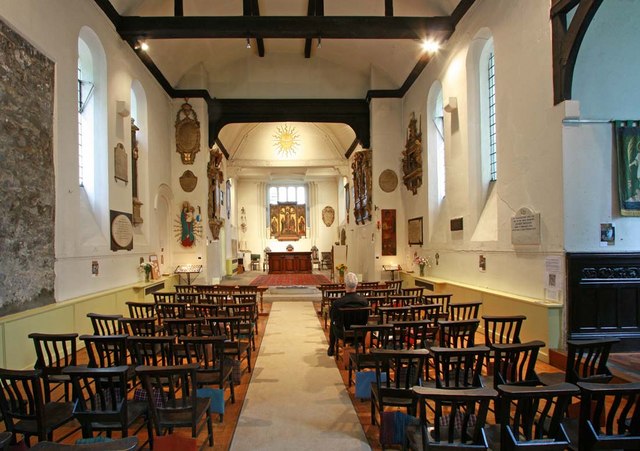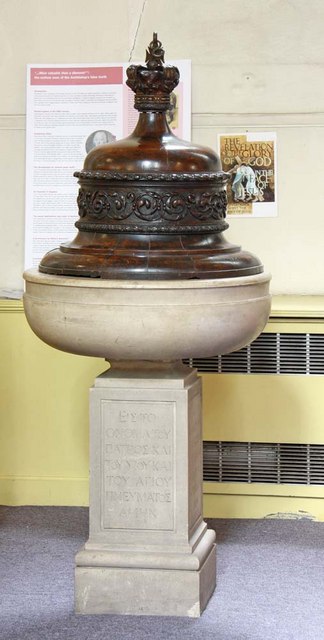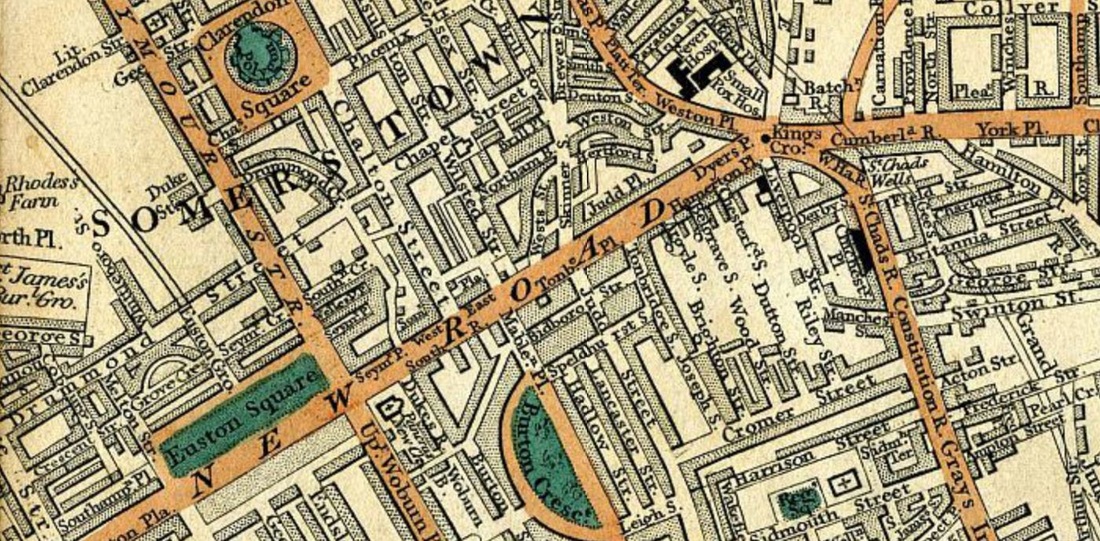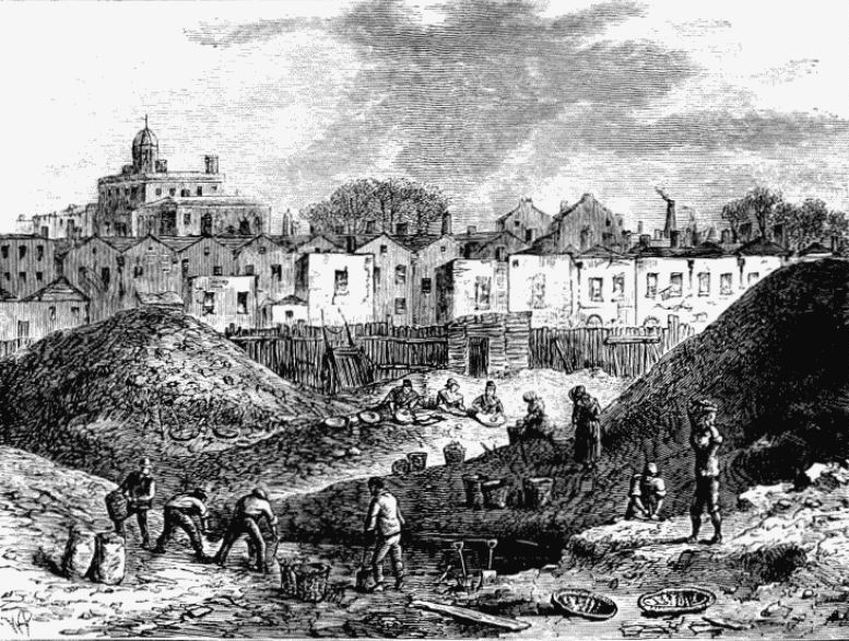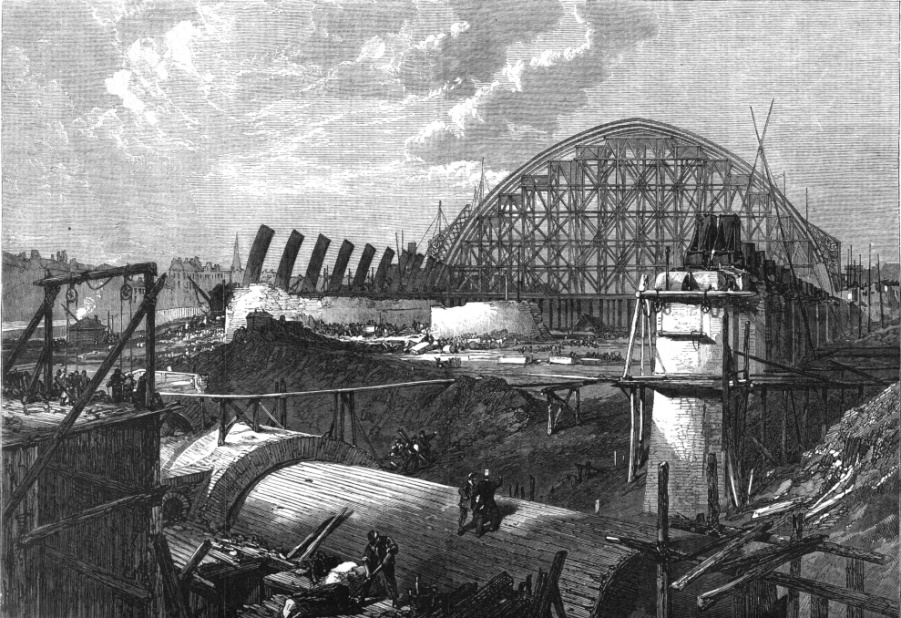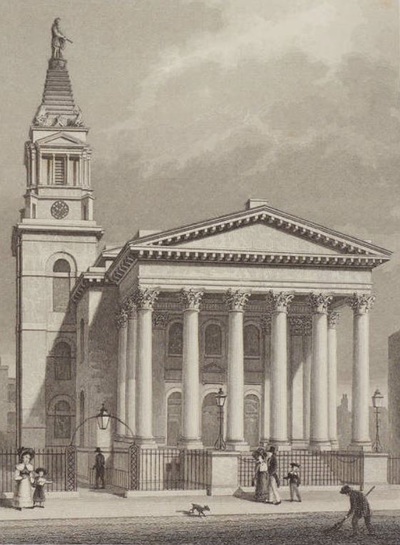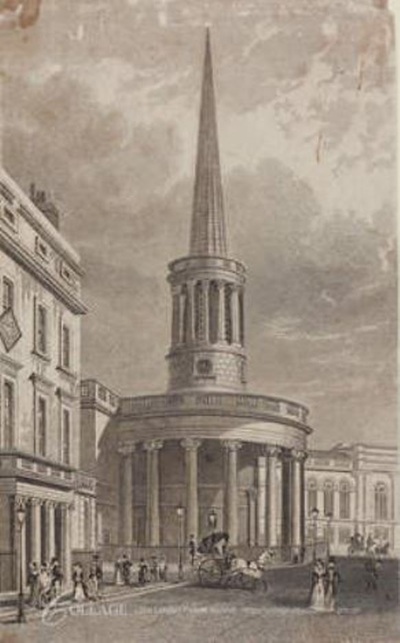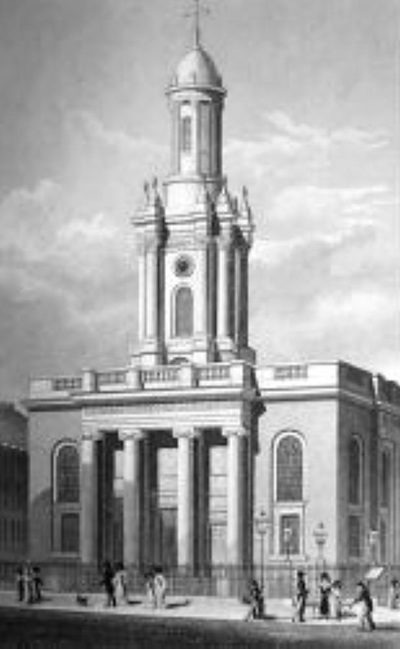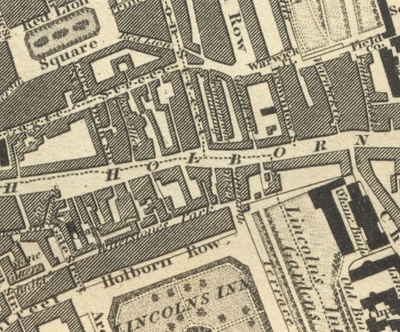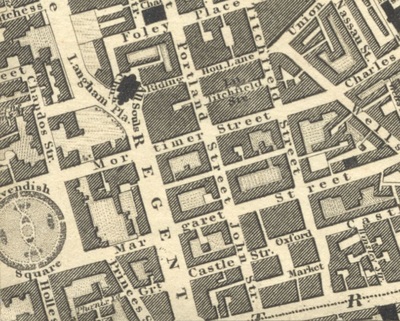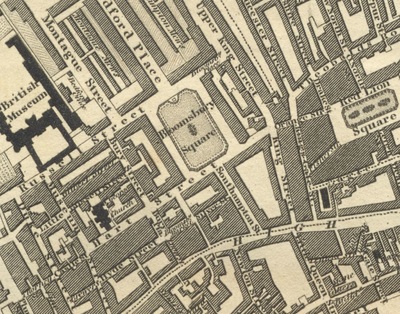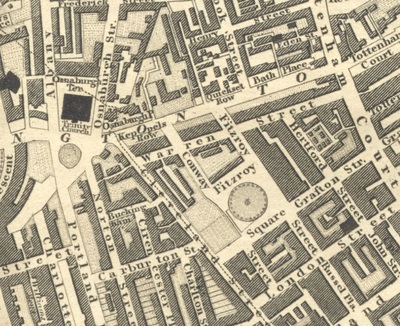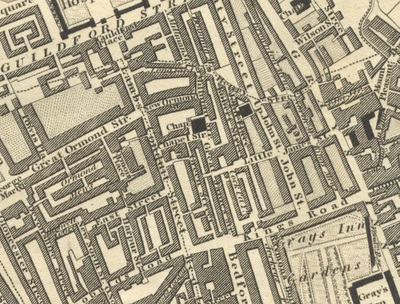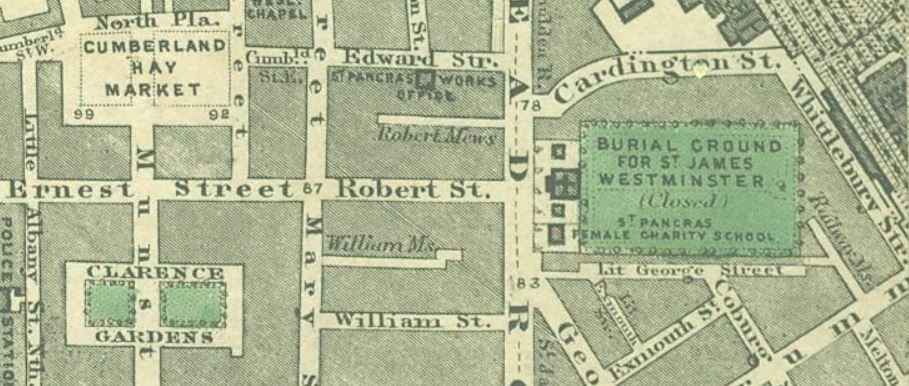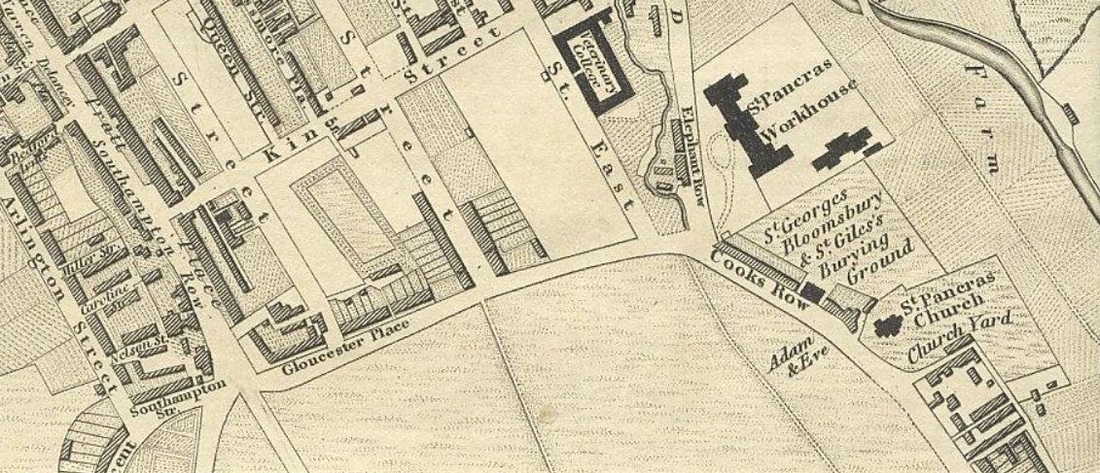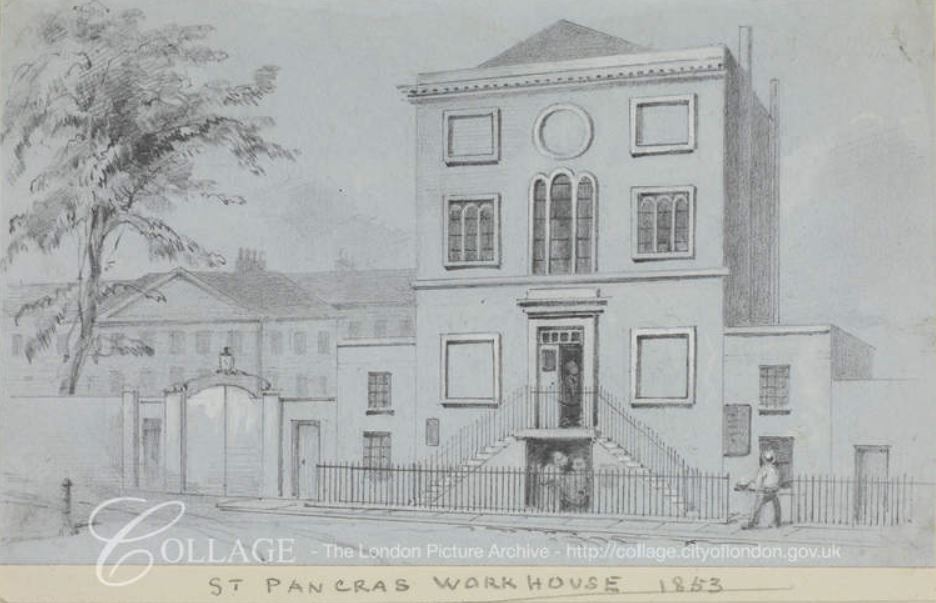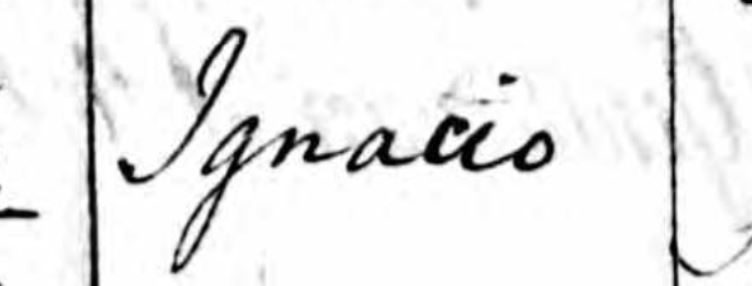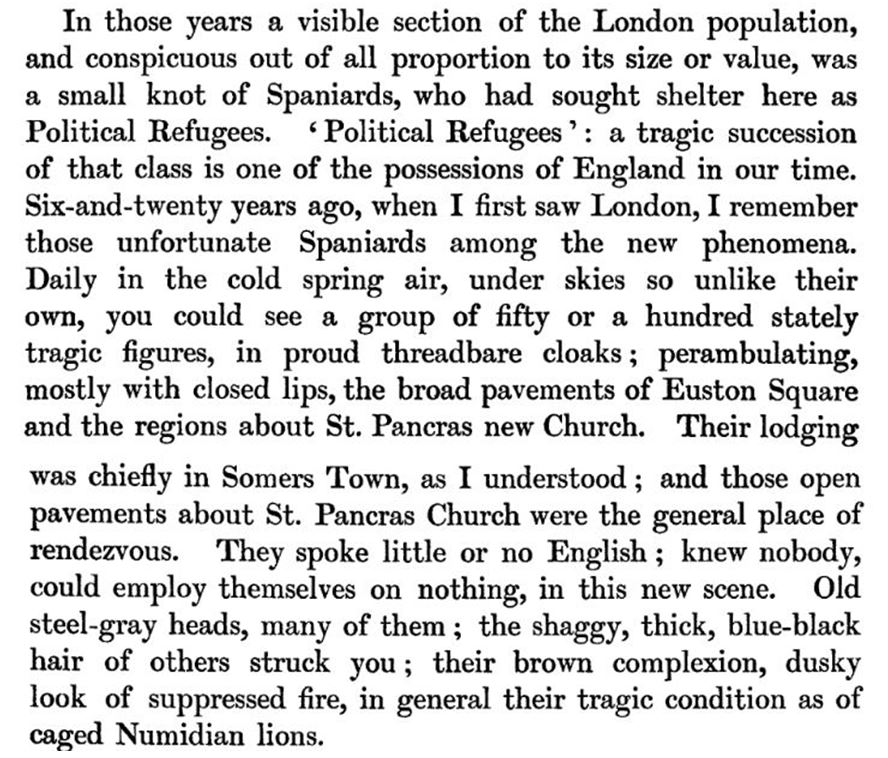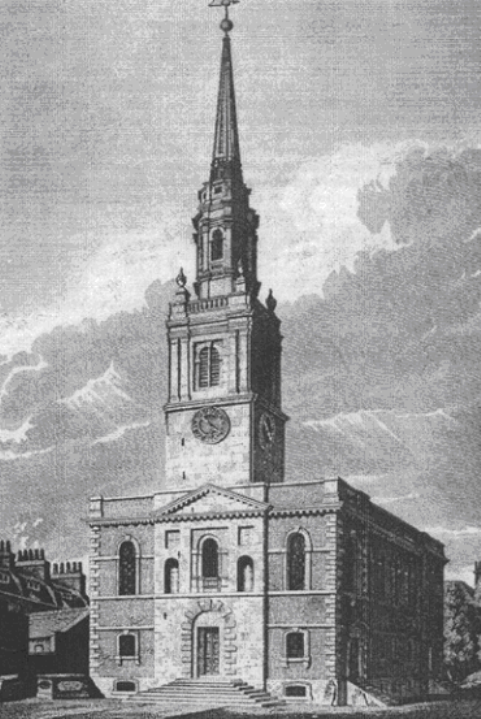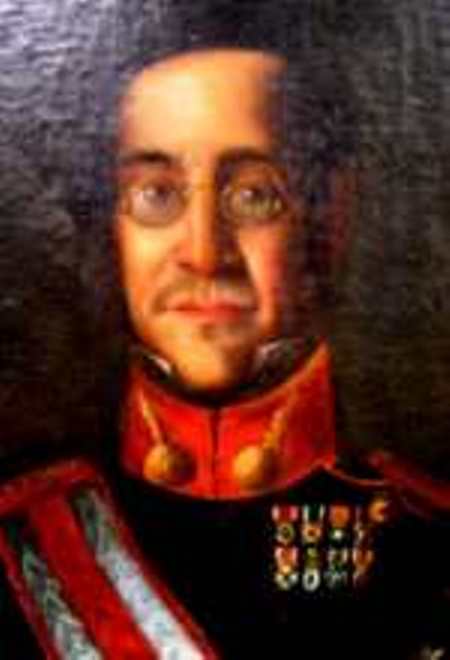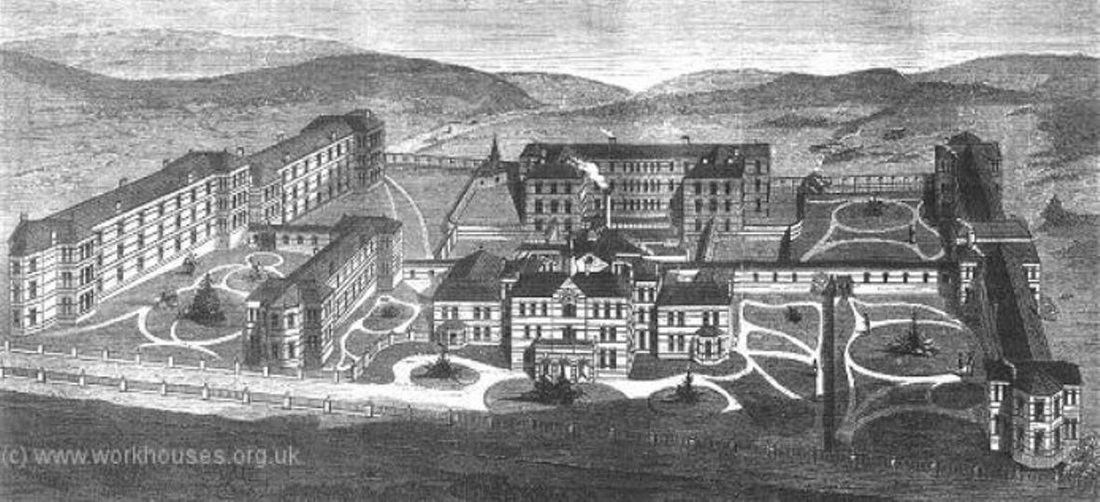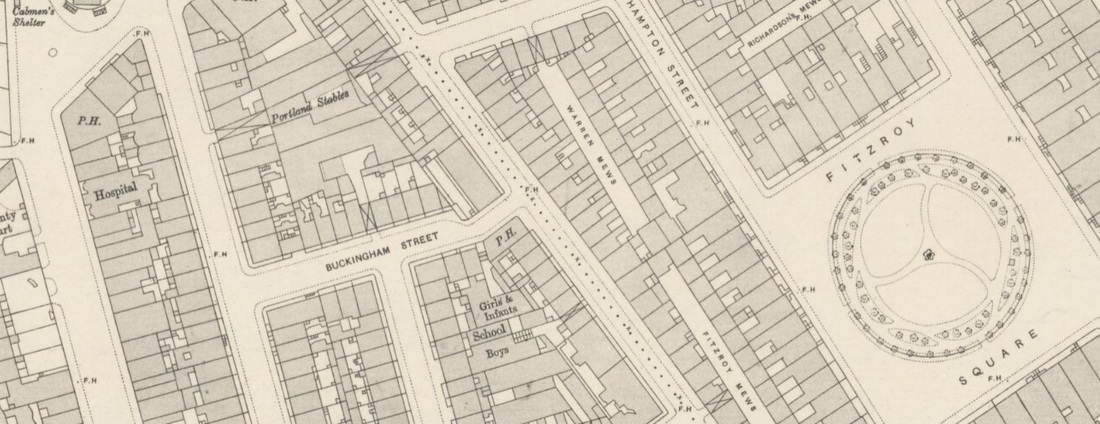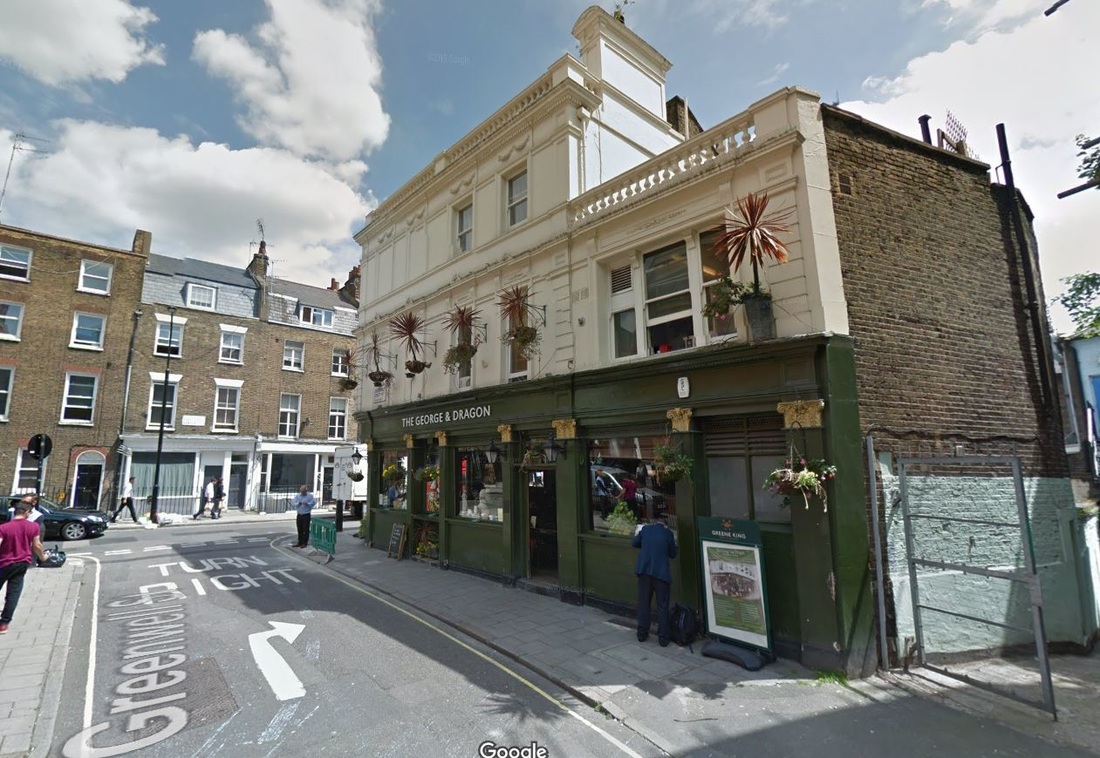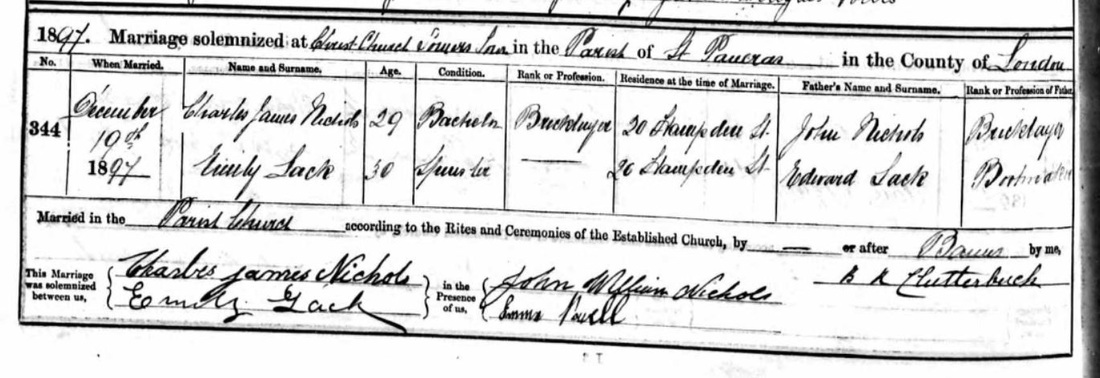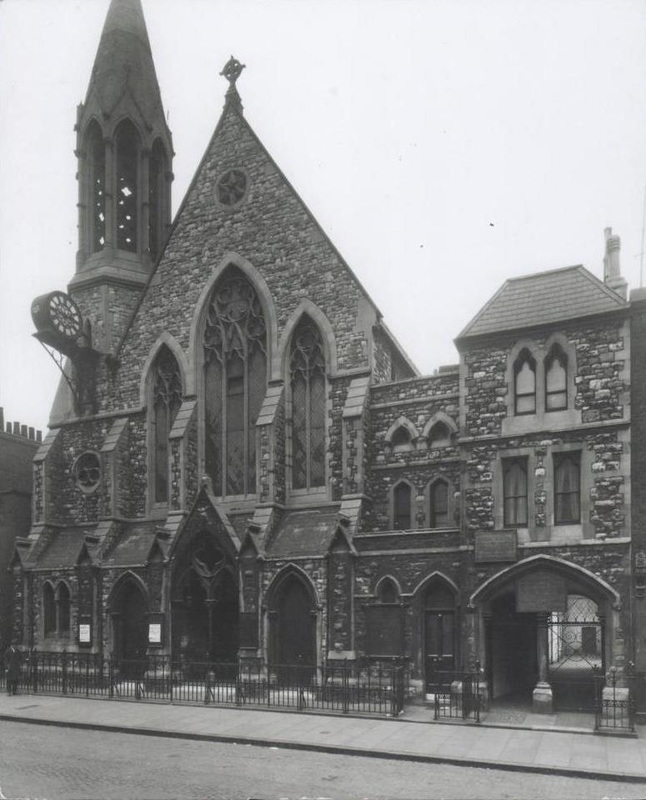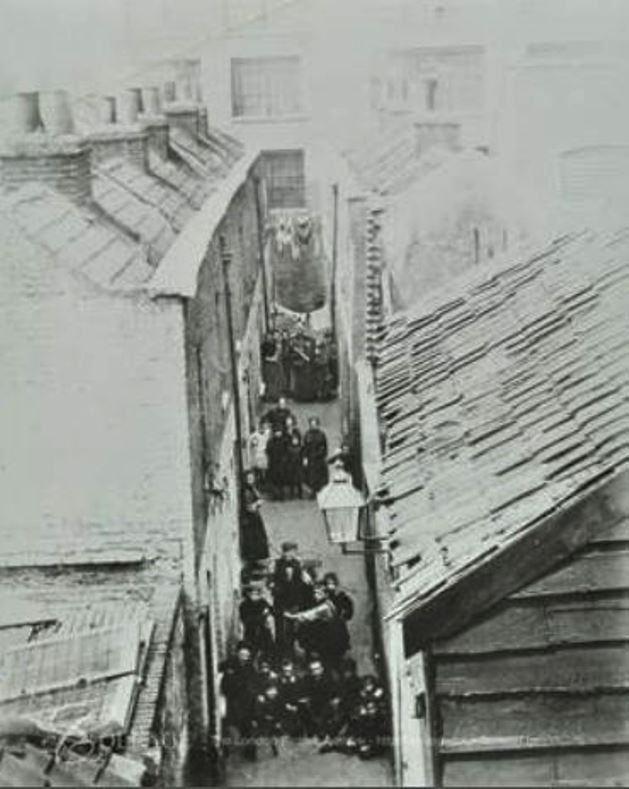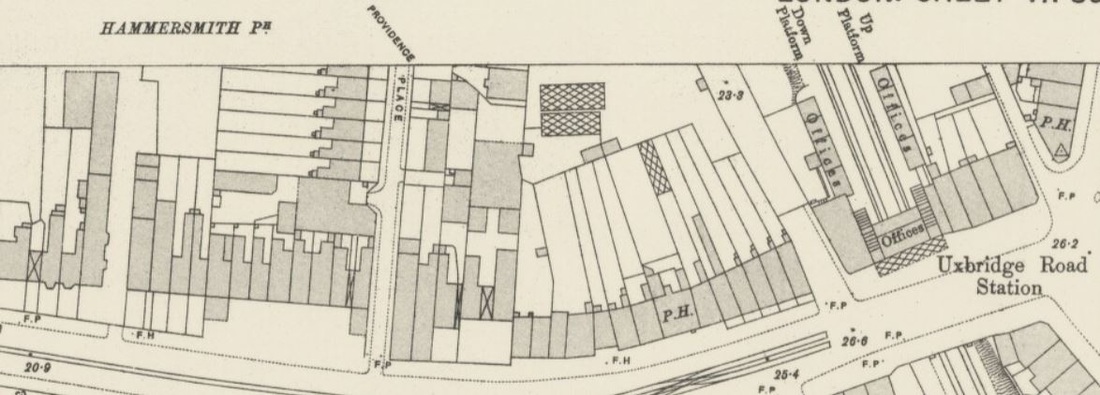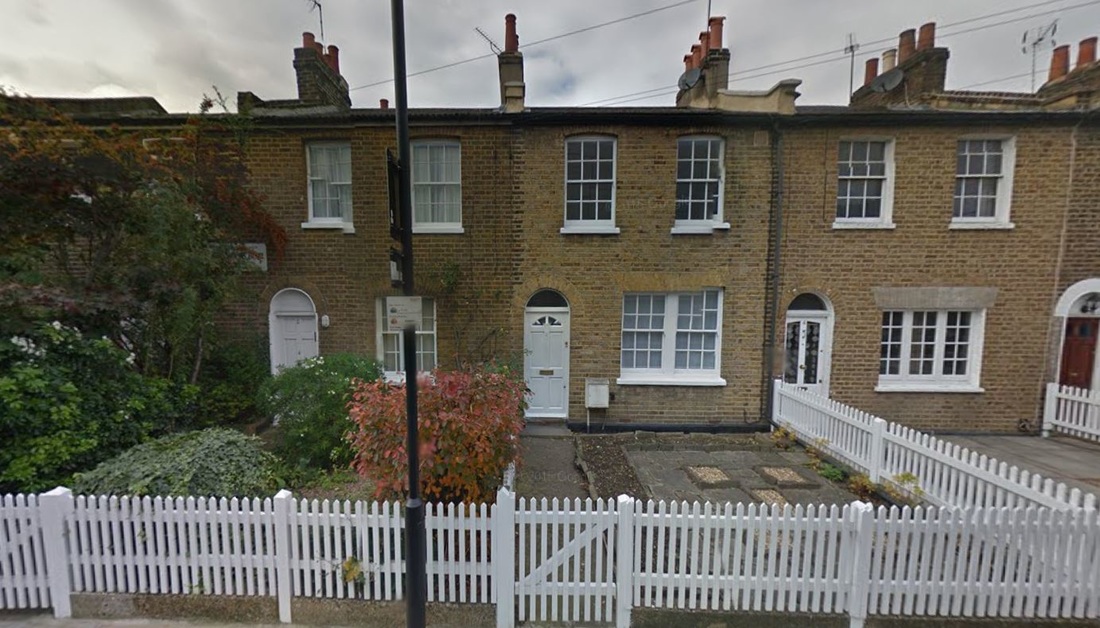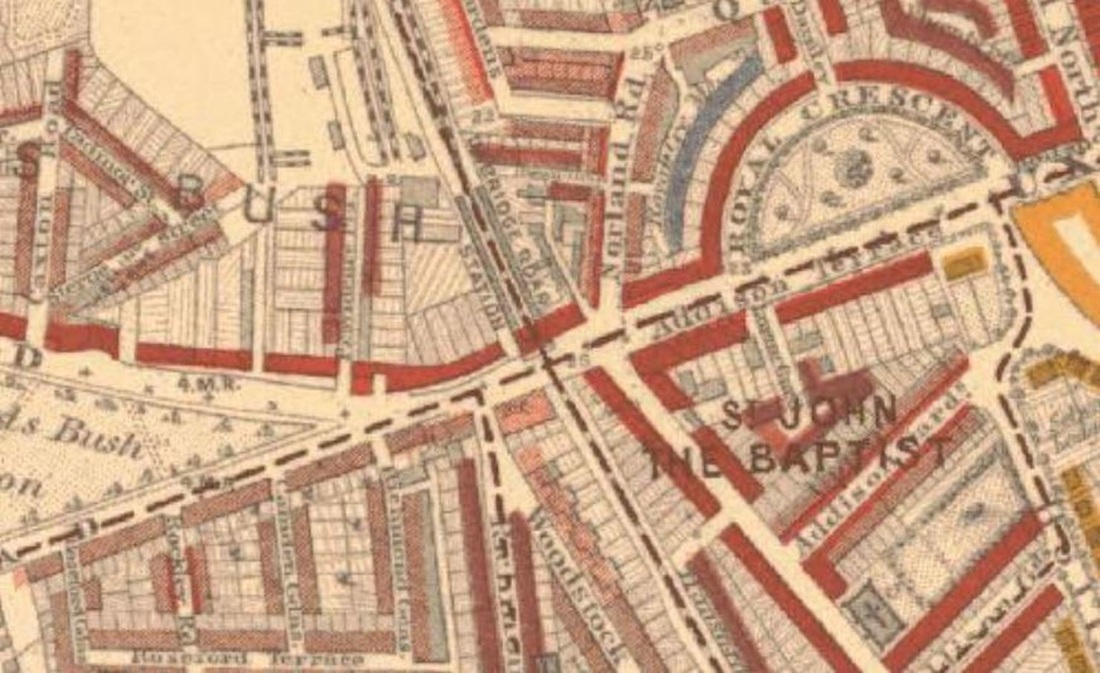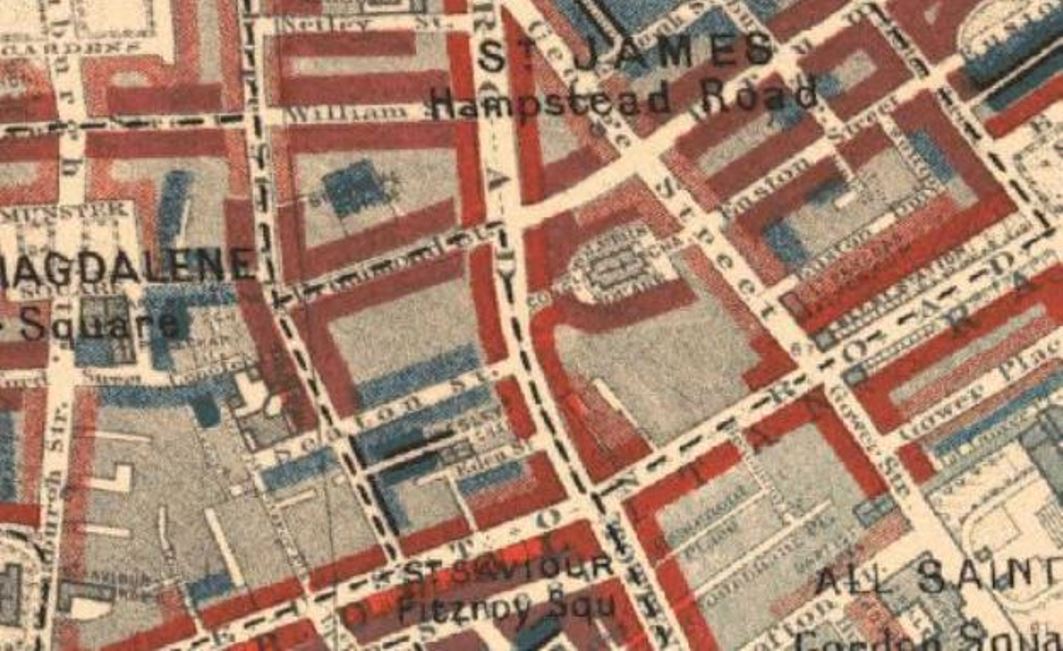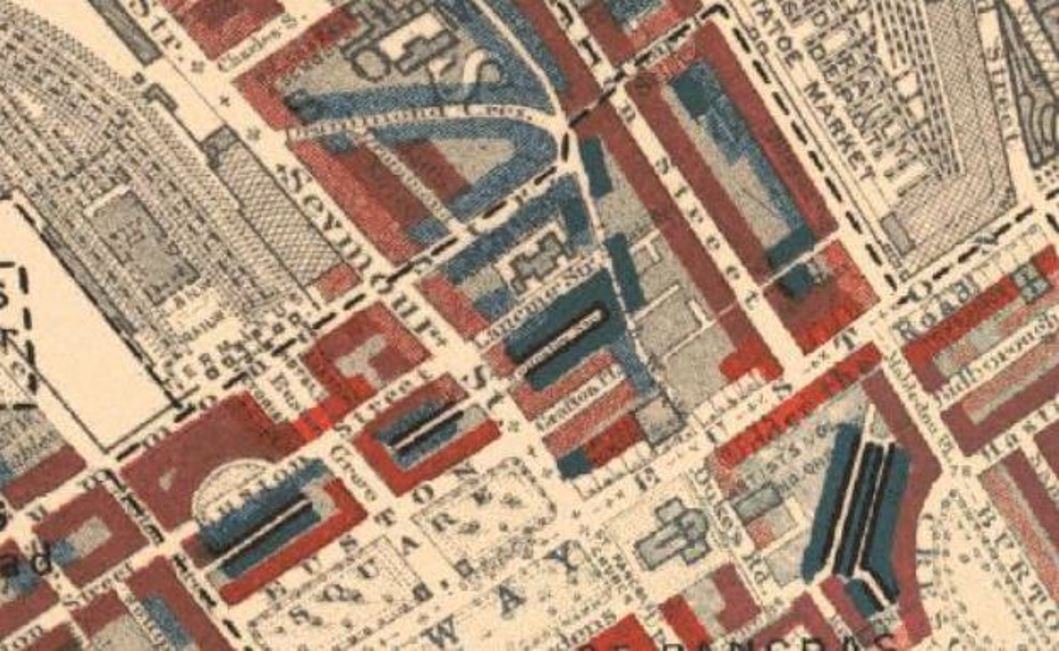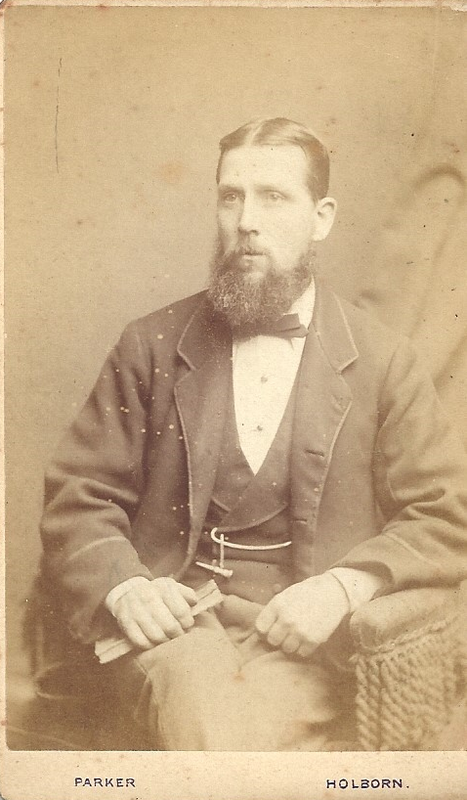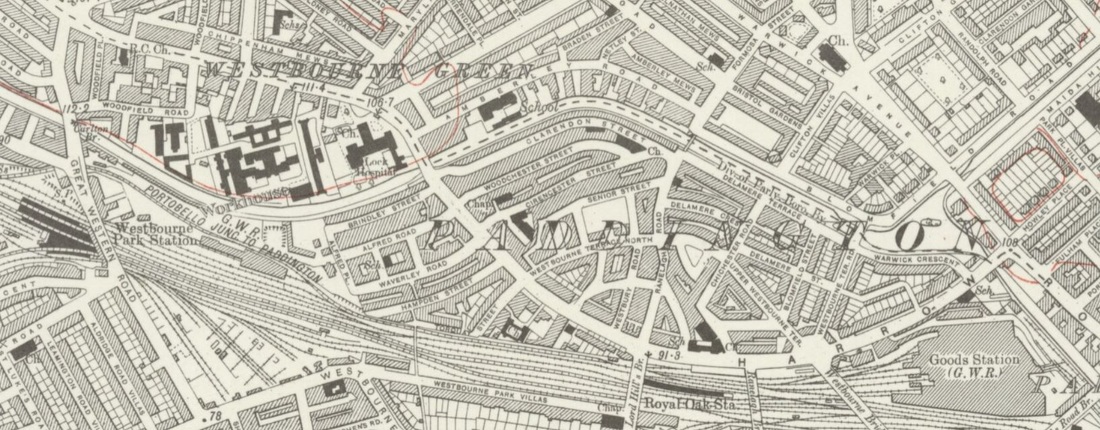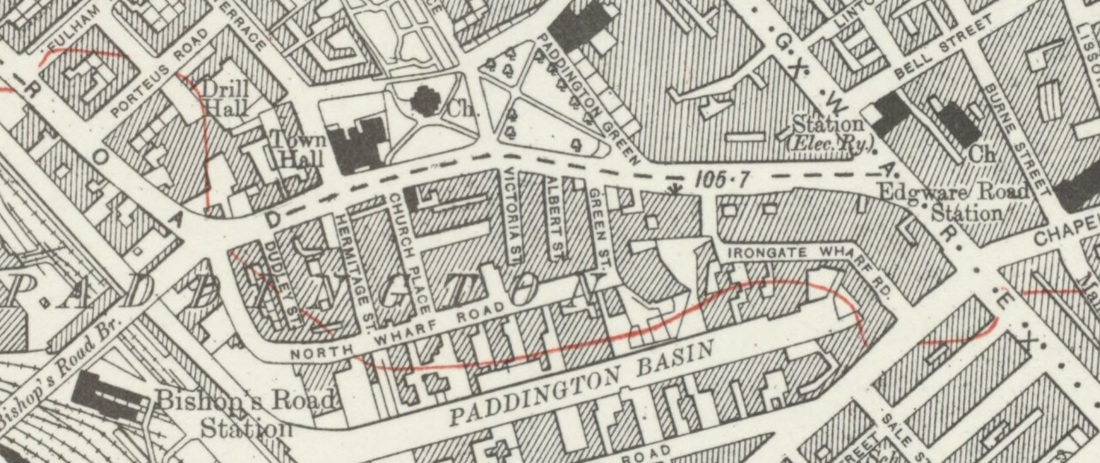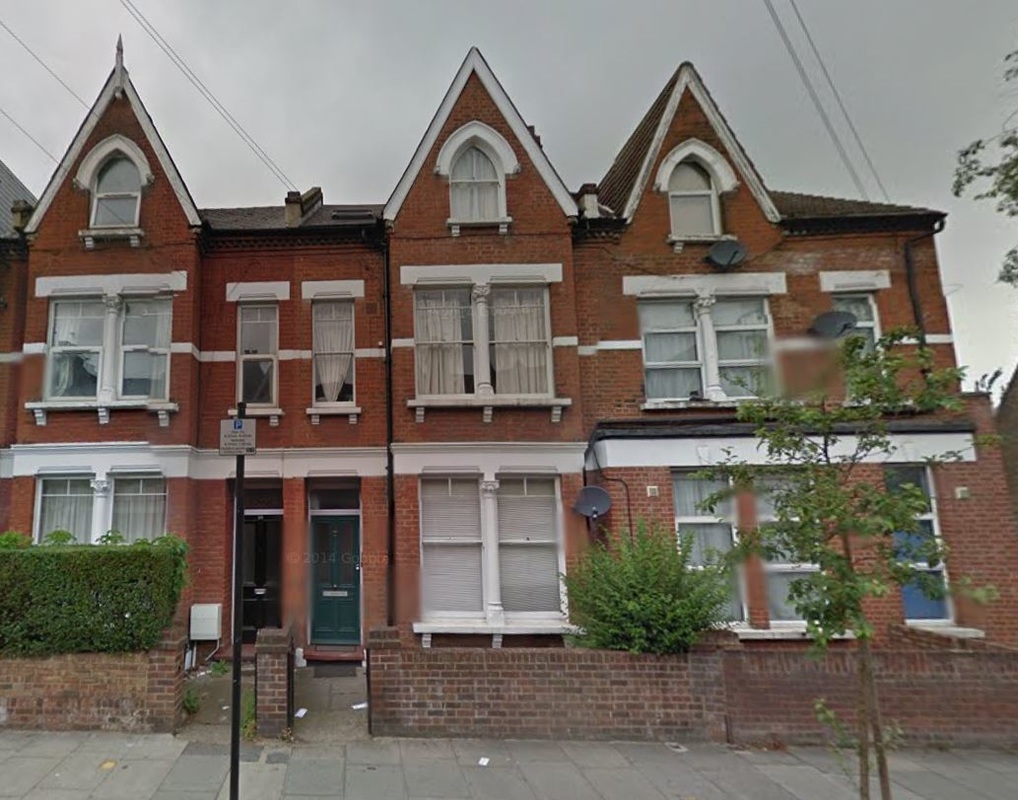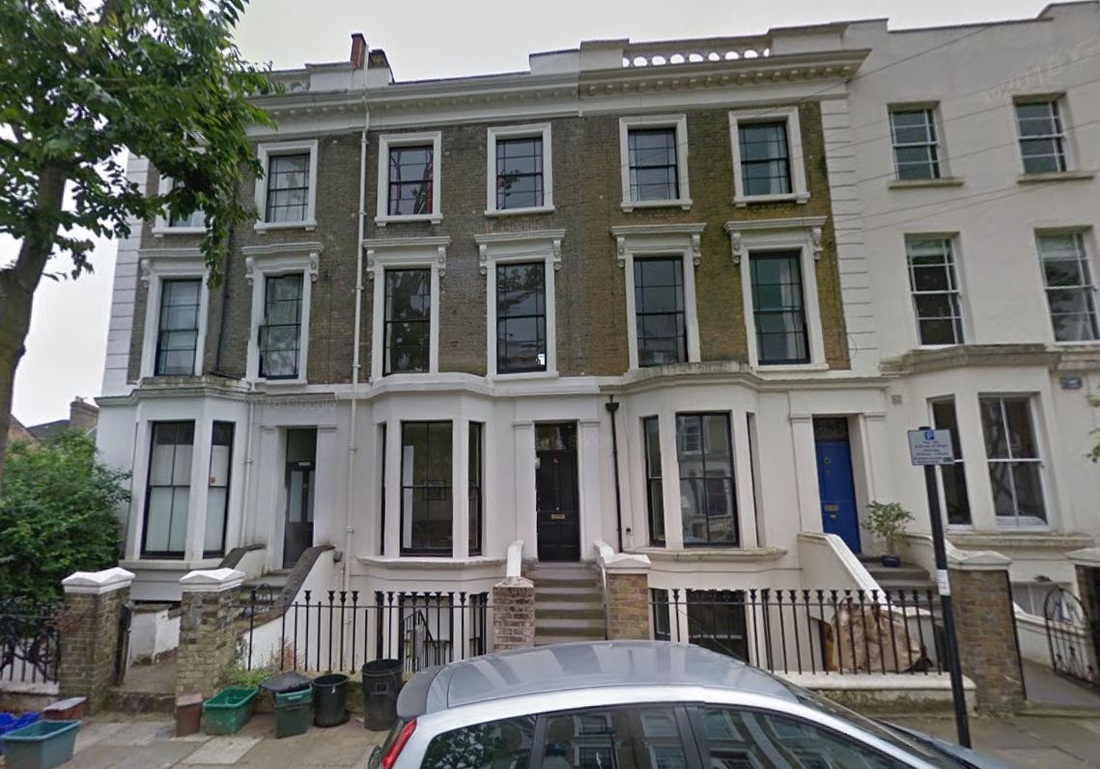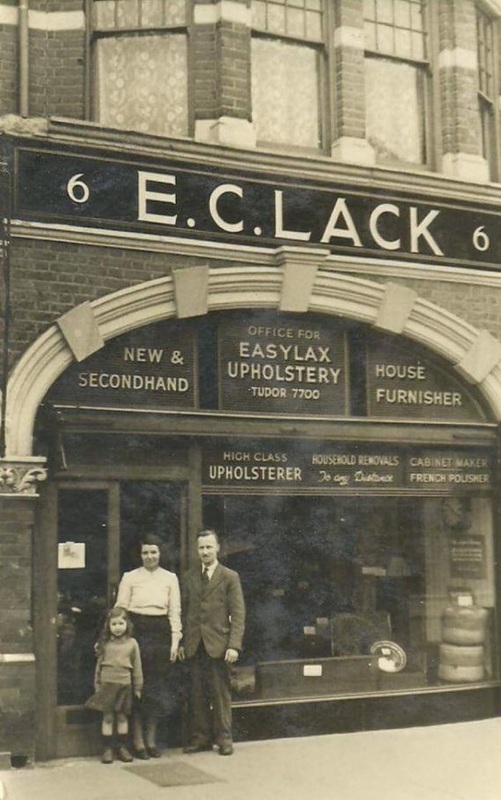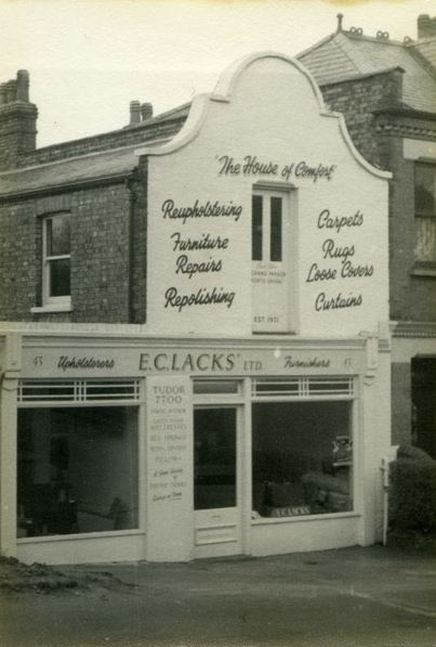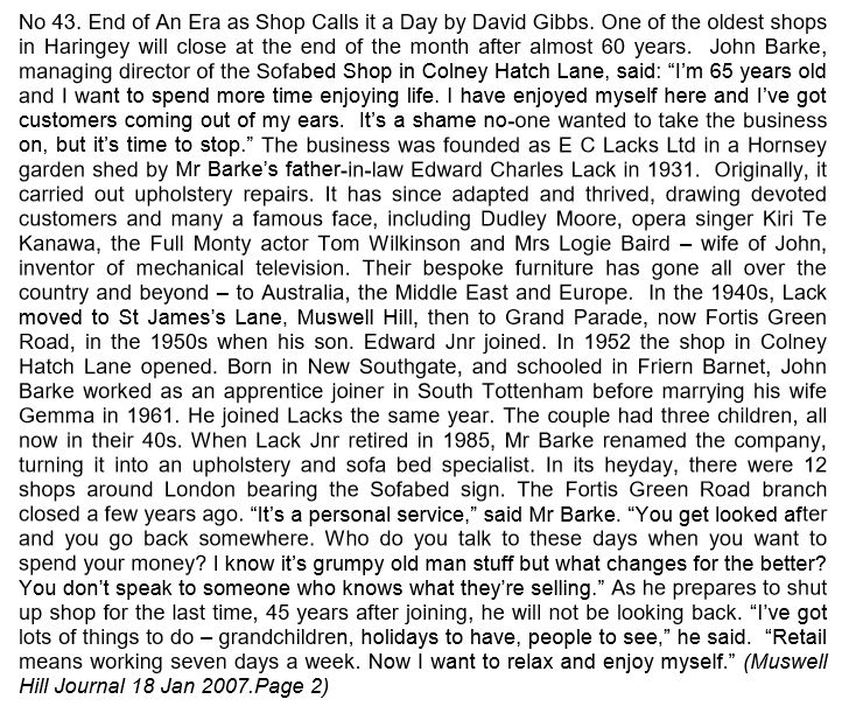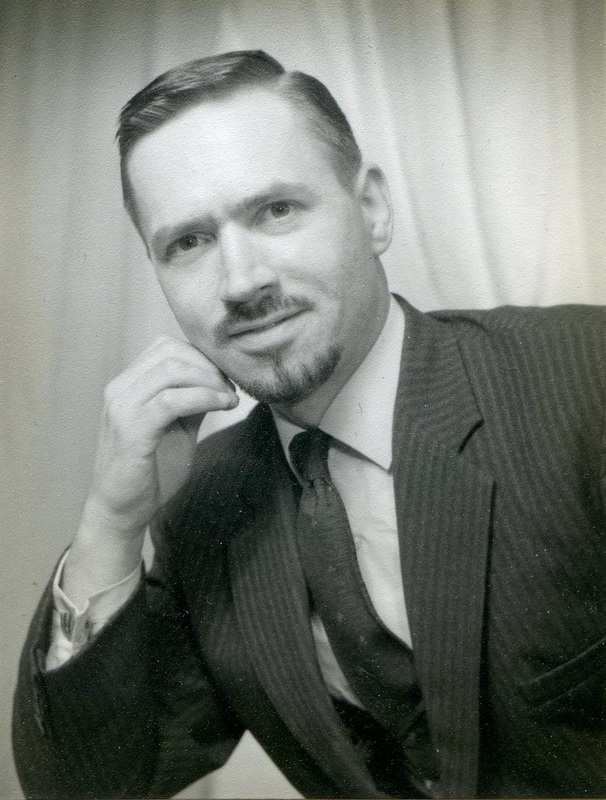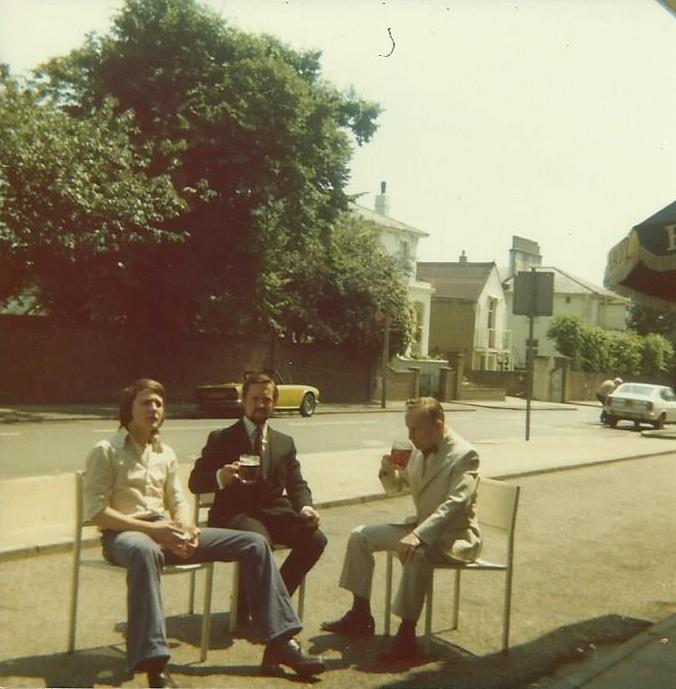a Succession of Edwards
|
From a family tree compiled in 1965 I was able to see that my father, Edward Charles Lack, was the last in a line of Lacks called Edward Charles, going back to an Edward Charles Lack born in 1864, and that these were preceded by an Edward Lack born in the 1820s and by his father Edward Lack, birth date unspecified.
|
From records now accessible online I have been able to satisfy an old curiosity and fill in some details about this succession of seven Edward Lacks.
Edward the First (1776?-1828?)
On November 11th 1801 Edward Lack married Dorcas Karrod at St John Horsleydown, in Southwark:
On November 11th 1801 Edward Lack married Dorcas Karrod at St John Horsleydown, in Southwark:
|
This view of the church, right, by Southwark-born artist John Buckler, is from 1799.
John Lack, whose presence at the wedding of Edward and Dorcas is indicated by his mark on the certificate, married Sarah in the same church in 1795. John is recorded as being a labourer, and in a later document as a cornporter. I would guess that he was the elder brother, and as such was given his father's name, meaning that the line of Edward Lacks probably begins with the younger brother Edward, husband of Dorcas. |
If the father of John and Edward Lack was called John, a good candidate might be John Lack of Upton cum Chalvey, near Slough, husband of Susanna. Their son John Lack was born in 1770, their son Edward in 1776. I have no evidence, yet, that these two are the John and Edward living in Southwark twenty years later.
The strangely named Dorcas Karrod was born August 25th 1782 in Purley, Berkshire, to Samuel and Ann.
Edward and Dorcas Lack had seven children: Edward Karrod (1802), William (1804), Samuel (1806), Charles Corbett (1813), Sophia (1815), Mary Ann (1819, died 1820) and Alfred (1821, died 1846). Edward is listed on the childrens' baptism records as a coach painter, with abode listed as Somers Town. All seven were baptised in St Pancras Old Church, seen here in 1815:
Edward and Dorcas Lack had seven children: Edward Karrod (1802), William (1804), Samuel (1806), Charles Corbett (1813), Sophia (1815), Mary Ann (1819, died 1820) and Alfred (1821, died 1846). Edward is listed on the childrens' baptism records as a coach painter, with abode listed as Somers Town. All seven were baptised in St Pancras Old Church, seen here in 1815:
The church was heavily remodelled in the 1840s. Some aspects of its earlier appearance were restored in the twentieth century. The font cover dates from 1700:
Edward and Dorcas moved from Southwark to Somers Town soon after their marriage in 1801, and don't seem to have moved again. No streets are specified in the birth certificates of their children, but the record of Mary Ann's death gives James Street as the abode:
James Street is in the middle of this map, running between West Street and Skinner Street. These streets were demolished for the building of St Pancras station in the 1860s.
I can't be sure it is the right one, but an Edward Lack who died in 1828, age 52, was living on Ossulton Street in Somers Town. He was buried in Saint James's burial ground, St Pancras (at the left edge of the map above).
When Dorcas died age 64 her address was Cirencester Place, off Carburton Street, just west of Fitzroy Square. She was living with her daughter Sophia, who had married Thomas Jones and had a daughter, Amelia. Dorcas was buried in January 1845 in the same burial ground.
The following year Dorcas's son Alfred, who had been living at the Colosseum Tavern on Carburton Street, was admitted to the St Marylebone workhouse as ill and destitute. He died a month later, aged 25.
When Dorcas died age 64 her address was Cirencester Place, off Carburton Street, just west of Fitzroy Square. She was living with her daughter Sophia, who had married Thomas Jones and had a daughter, Amelia. Dorcas was buried in January 1845 in the same burial ground.
The following year Dorcas's son Alfred, who had been living at the Colosseum Tavern on Carburton Street, was admitted to the St Marylebone workhouse as ill and destitute. He died a month later, aged 25.
Edward the Second (1802 - late 1830s?)
Edward Karrod Lack married Susanna Southey in 1822, at St Pancras Old Church. He was also a coach painter. They had at least five children: Emma (1823 - baptised at St George's, Bloomsbury), Edward Ignacio (1825 - All Souls, Marylebone), Eliza (1828 - St George's),William (1831 - Trinity Church, Marylebone) and Mary Ann (1836 - St George's):
Edward Karrod Lack married Susanna Southey in 1822, at St Pancras Old Church. He was also a coach painter. They had at least five children: Emma (1823 - baptised at St George's, Bloomsbury), Edward Ignacio (1825 - All Souls, Marylebone), Eliza (1828 - St George's),William (1831 - Trinity Church, Marylebone) and Mary Ann (1836 - St George's):
In 1824 they were living on Brownlow Street, in 1826 on (now Great) Castle Street, in 1828 on Little Russell Street, in 1831 on Buckingham (now Greenwell) Street and in 1836 on Mount Pleasant:
Edward and Susannah's frequent changes of district contrast dramatically with the fidelity to Somers Town of the previous generation. The Lack family had returned there by 1841, when Susannah Lack was living with her children Eliza, William and Mary Ann on Whittlebury Street, just east of the St James Burial Ground, next to the newly built Euston Station:
No sign of daughter Emma, nor of husband Edward - married and dead, respectively, is my guess. The boy Edward Ignacio wasn't there either. Perhaps, shorn of his exotic second name, he was the Edward Lack registered at the St Pancras Infirmary, i.e. the Workhouse:
There is something odd among the entries in this 1828 register of baptisms:
It records the baptism of Eliza, Edward and Susannah's third child, as solemnised in the parish of Saint George, Bloomsbury, on July 27 1828, with the date of birth (May 7th), the parents' abode (Little Russell Street) and father's quality, trade or profession (coach painter) properly noted.
But immediately beneath that record is the record of the baptism on the same day of her brother Edward. The oddity is that the recorded date of his birth, December 12th 1825, is not, as it was in Eliza's case, twelve weeks earlier but more than two and a half years earlier. I suppose that there are many reasons for delaying a baptism, even by years, but I can't think of a reason for baptising someone years after their birth if, as is the case in this case, they had already been baptised just after that event. This is the record of Edward's baptism on January 1st 1826, twenty days after his birth on December 12th 1825:
But immediately beneath that record is the record of the baptism on the same day of her brother Edward. The oddity is that the recorded date of his birth, December 12th 1825, is not, as it was in Eliza's case, twelve weeks earlier but more than two and a half years earlier. I suppose that there are many reasons for delaying a baptism, even by years, but I can't think of a reason for baptising someone years after their birth if, as is the case in this case, they had already been baptised just after that event. This is the record of Edward's baptism on January 1st 1826, twenty days after his birth on December 12th 1825:
The parents' abode is different (53 Castle Street) and the father's quality, trade or profession is less specific ('trade'), but the date is the same.
Curious as I am on this point, the reason for this digression is not the question: Why was Edward baptised twice? but: Why, when baptised a second time, did he acquire the name Ignacio? My confirmation name is Ignatius, and I know roughly why - something to do with honouring the school named for that saint in Stamford Hill, attended by my father (and then by my brother Christophe and me). Something must have prompted the choice made by Edward and Susannah. There are, we have seen, no discernible Ignacios in Edward's family line. Susannah was the daughter of John and Sarah, and in the little I can see of that lineage there are no Ignacios either.
A search for Ignacios in London c.1826 turns up a very interesting individual, the Spanish political exile Ignacio Lopez Pinto. There was a community of such exiles in Somers Town, distinctively described by Thomas Carlyle (The Life of John Sterling, 1897, pp. 64-65):
Ignacio Lopez Pinto was a key figure in this community, and a significant personage on his return to Spain in the 1830s. In Somers Town he did not keep his distance like his compatriots. He made the acquaintance of a local girl, Sarah, and on May 15th 1830 they were married at St James's Clerkenwell.
|
Sarah's maiden name was Southey; her parents were John and Sarah Southey. The wife of Edward Karrod Lack was Susannah Southey, daughter of John and Sarah Southey. My guess is that Sarah and Susannah were sisters and that, for some time before marrying Sarah, Ignacio Lopez Pinto had been a friend of the family and that, before he eventually became the uncle of young Edward, their acquaintance with Ignacio had prompted Edward and Susannah to give the extra name Ignacio to their child Edward. Perhaps Ignacio Lopez Pinto served as his godfather - these things aren't recorded.
|
|
There is a further onomastic oddity attaching to this story. Sarah Southey was baptised, as an adult, on April 21st 1830 at St James's Clerkenwell, seven weeks before her wedding there to Ignacio Lopez Pinto. The register notes that she was born twenty-six years before, and gives her name as Asuncion Sarah Southey. I'm sure this is not the name she was given by John and Sarah Southey on August 10th 1804, or shortly after. I don't understand why she acquires that name in 1830 but it is the one by which she is recorded in histories that relate the life of her eminent husband, Ignacio.
(End of digression.) |
Edward the Third (1825-1897)
The 1851 census tells us that Edward Ignacio, son of Edward and Susannah, now twenty-four, was living at 26 Churchway in Somers Town, and working as a boot and shoe maker. In 1856 he married Mary Ann Sumner, who gave birth to Edward Charles in 1864, Emily in 1866 and Ann in 1867 (died 1870). In 1889, according to the electoral register, they were still at 26 Churchway. By 1891, the family had moved out. Suffering from bronchitis, Edward entered the Highgate Infirmary, where, in February 1897, he died aged 70.
The 1851 census tells us that Edward Ignacio, son of Edward and Susannah, now twenty-four, was living at 26 Churchway in Somers Town, and working as a boot and shoe maker. In 1856 he married Mary Ann Sumner, who gave birth to Edward Charles in 1864, Emily in 1866 and Ann in 1867 (died 1870). In 1889, according to the electoral register, they were still at 26 Churchway. By 1891, the family had moved out. Suffering from bronchitis, Edward entered the Highgate Infirmary, where, in February 1897, he died aged 70.
Mary Ann and daughter Emily moved to 6 Buckingham Street (now Greenwell Street), two doors down from where the Lack family had been living in 1831:
Nothing remains on this street from the period, except the pub on the corner with Cleveland Street:
|
The 1891 Census lists Mary Ann as a nurse, as in 1881; Emily is a machinist. Edward junior was now a glass-cutter and glazier, had married and moved to Shepherd's Bush (see below).
In December 1897 Emily married Charles James Nichols, a bricklayer, at Christ Church on Chalton Street in Somers Town: The church was completely destroyed by WW2 bombing.
|
Edward the Fourth (1864-1901)
|
At the time of the 1881 Census, Edward Charles was 17 years old, living with father Edward, mother Mary Ann and sister Emily at 26 Churchway. He was working as a piano forte maker. In 1885 he married Mary Ann Malin. They had five children, Edward Charles (born 1885), Ruth Emily (1887), Tom William (1888), Ethel (1890 - died 1894) and George Morris (1892). |
To begin with they were still living on Churchway, but at the time of the 1891 Census they were at 3 Providence Place in Shepherd's Bush:
Providence Place is now Shepherd's Bush Place, a terrace of houses built in the 1820s and Grade II listed. If the numbering hasn't changed, this is the house:
Edward, Mary Ann and their four children lived here with another family, two adults and two children. Charles Booth's poverty map of 1898 marks the street in purple, meaning 'mixed - some comfortable, others poor':
By July 1891 this part of the Lack family was back in Somers Town, just east of Euston Station, at 11 Drummond Street (two rooms on the second floor, at six shillings and sixpence a week). Booth's map marks this part of Drummond Street in light blue, meaning 'poor'. In 1899 the family was still on Drummond Street but further down the street at 169-71, living in 'model dwellings'. This part of the street is marked in purple:
|
According to the 1901 Census the family comprised Mary Ann with children Edward, Ruth, Tom and George. The father Edward was registered elsewhere by the Census, having been admitted to the Highgate Infirmary, like his father before him. Like his father, he died there. His death, aged 38, is registered as occurring between April and June 1901. My uncle Peter affirms that the photograph, right, is his great grandfather, Edward Charles Lack. Peter remembers being told that the illness that killed him came from having rescued someone who had fallen into a canal or lake. |
Update, 19.12.2018: I couldn't find any newspaper accounts to corroborate the fatal rescue story, but I did come across an incident from this Edward's earlier life, as reported in the Islington Gazette of October 5th 1887:
The next time I stagger out from the Doric Arch at Euston Station and find myself on Churchway, I shall remember the misdemeanours of my great great grandfather.
(By the time of the 1911 Census, Edward's widow Mary Ann had married William Kerby, a Royal Marine. She was living on William Road, just north of Drummond Street, with her sons Tom and George.)
Edward the Fifth (1885-1931)
In 1907 Edward Charles Lack married Edith Gertrude Prothero, whose family had been living near Drummond Street (Clarence Gardens and then Stanhope Street). The 1911 electoral register shows an Edward Charles Lack living in Paddington:
In 1907 Edward Charles Lack married Edith Gertrude Prothero, whose family had been living near Drummond Street (Clarence Gardens and then Stanhope Street). The 1911 electoral register shows an Edward Charles Lack living in Paddington:
If this one room was the home of the Lack family at the beginning of the year, by April, according to the Census, they had moved to two rooms in Victoria Street, Paddington:
Edward was working as a grocer's assistant. They had an eleven-month old son, Edward Charles Jonathan. Edith's father was called Jonathan, which explains the added third name.
By 1913 they had moved north to 25 Fifth Avenue, on the Queen's Park estate:
By 1913 they had moved north to 25 Fifth Avenue, on the Queen's Park estate:
After Providence Place, this is the second instance where the home of an Edward Lack is still standing. The houses on Fifth Avenue were built in 1880.
Edward, Edith, Edward and Elsie (born 1914) were at 25 Fifth Avenue at least until 1915. In 1918 Edward senior was registered at 118 Third Avenue, two streets away. That house, now gone, was 'double-fronted with six rooms', according to young Edward's recollections. Having acquired the right to vote in 1918, Edith was also electorally registered at this address. She died a year later, aged 32 (the death was registered at Paddington between July and September 1919).
If the registers are to be believed, in this same three-month period in 1919 Edward married again. Eleanor Perrin was the widow of Jesse Perrin, killed in action on June 11th 1918.
Eleanor already had three children by Jesse. Edward and Eleanor had eight children: Dennis, Reginald, Eleanor, Raymond, Leslie, Gwendolyn, Doris and Anthony. Edward's address in 1931 was Davenant Road, N.19, but he died that year in Highgate Infirmary, like his father in 1901 and his grandfather in 1897.
Eleanor already had three children by Jesse. Edward and Eleanor had eight children: Dennis, Reginald, Eleanor, Raymond, Leslie, Gwendolyn, Doris and Anthony. Edward's address in 1931 was Davenant Road, N.19, but he died that year in Highgate Infirmary, like his father in 1901 and his grandfather in 1897.
Edward the Sixth (1910-1975)
Edward Charles Jonathan Lack (my grandfather) married Alice Ellen Hill in 1931. In the 1930s Edward and Alice lived at three different N.19 addresses: 101 Fairbridge Road, 8 Francis Terrace and 291 Sussex Way. The first two of these survive, the third has been demolished:
In 1944 they moved to Grosvenor Gardens in Muswell Hill, where their son Peter still lives.
They had seven children: Edward Charles (my father, 1931), Angela (1933), Peter (1936), Gemma (1942), Rita (1944), Helen (1945) and Christine (1954). That is Helen with her parents in the photograph below left:
They had seven children: Edward Charles (my father, 1931), Angela (1933), Peter (1936), Gemma (1942), Rita (1944), Helen (1945) and Christine (1954). That is Helen with her parents in the photograph below left:
The history of the Lack family business was related by my uncle Johnnie (much missed) for the Muswell Hill Journal in 2007:
|
Edward the Seventh (1931-2009)
My father, right, brought the succession of Edwards to a halt by calling his first son Christophe, though he did then add the names Edward and Charles as a concession to family history. Christophe added the names Edward and Charles to that of his son Daniel, and I have inserted Edouard and Charles between my son's two more exotic forenames. That, then, is the endpoint to which the line has meandered over these last two hundred and or so years. |
I undertook this research to satisfy my own curiosity, but I know that the results would have as strongly interested my brother, Christophe Edward Charles Lack (1958-2014), and I am sorry not to be able to share them with him. Here he is, c.1974, sharing a pint outside the Rosetti in Saint John's Wood with Edward Charles Lack (1931-2009) and Edward Charles Jonathan Lack (1910-1975). All three are very much missed.
